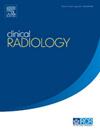锥形束计算机断层扫描(CT)辅助放射插入式胃造口术。技术考虑因素和对辐射剂量的影响
IF 2.1
3区 医学
Q2 RADIOLOGY, NUCLEAR MEDICINE & MEDICAL IMAGING
引用次数: 0
摘要
目的:术中锥形束计算机断层扫描(CT)可以为逆行放射插入式胃造口术(RIG)提供解剖学评价。本研究探讨了锥束ct辅助RIG的技术和辐射剂量影响,并将其与仅使用透视的传统RIG技术进行了比较。材料与方法我们分析了107例逆行RIG手术,其中48例使用锥束CT辅助,59例仅使用常规透视。结果48例锥形束ct辅助RIG手术中46例(95.8%)成功,59例常规RIG手术中47例(79.6%)成功。传统的RIG技术遇到了一个并发症(管移位)。锥束ct辅助RIG的平均剂量面积积(DAP)显著高于8.5 Gy。常规技术DAP为3.4 Gy.cm2。锥束ct辅助RIG的平均程序和透视筛查时间明显较低。结论锥形束ct辅助RIG是一种安全有效的技术。虽然患者的辐射剂量增加了,但明确的解剖评估、更高的成功率和减少介入人员透视筛查暴露的主要并发症的缺乏抵消了这一影响。本文章由计算机程序翻译,如有差异,请以英文原文为准。
Cone beam computed tomography (CT)–assisted radiologically inserted gastrostomy. Technical considerations and impact on radiation dose
AIM
Intraprocedural cone beam computed tomography (CT) can provide anatomic evaluation during retrograde radiologically inserted gastrostomy (RIG). This study explores the technical and radiation dose implications of cone beam CT-assisted RIG, compared with conventional RIG technique using fluoroscopy alone.
MATERIALS AND METHODS
One hundred seven retrograde RIG procedures were included in the analysis, 48 of which were performed with cone beam CT assistance and 59 using conventional fluoroscopy alone.
RESULTS
Forty six of the 48 (95.8%) cone beam CT-assisted RIG procedures and 47 of the 59 (79.6%) procedures using conventional RIG technique were successful. One complication (tube malplacement) was encountered with the conventional RIG technique. Cone beam CT-assisted RIG was associated with significantly higher average dose area product (DAP) of 8.5 Gy.cm2 compared with conventional technique’s DAP of 3.4 Gy.cm2. The average procedure and fluoroscopic screening time for cone beam CT-assisted RIG was significantly lower.
CONCLUSION
Cone beam CT-assisted RIG is a safe and effective technique. Whilst there is an increase in radiation dose for the patient, it is counter balanced by definitive anatomical evaluation, higher success rates and lack of major complication with reduced fluoroscopic screening exposure for interventional staff.
求助全文
通过发布文献求助,成功后即可免费获取论文全文。
去求助
来源期刊

Clinical radiology
医学-核医学
CiteScore
4.70
自引率
3.80%
发文量
528
审稿时长
76 days
期刊介绍:
Clinical Radiology is published by Elsevier on behalf of The Royal College of Radiologists. Clinical Radiology is an International Journal bringing you original research, editorials and review articles on all aspects of diagnostic imaging, including:
• Computed tomography
• Magnetic resonance imaging
• Ultrasonography
• Digital radiology
• Interventional radiology
• Radiography
• Nuclear medicine
Papers on radiological protection, quality assurance, audit in radiology and matters relating to radiological training and education are also included. In addition, each issue contains correspondence, book reviews and notices of forthcoming events.
 求助内容:
求助内容: 应助结果提醒方式:
应助结果提醒方式:


